Blue Ensign
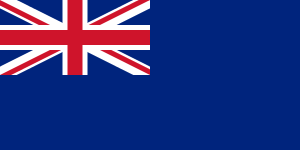 | |
| Use |
State ensign |
|---|---|
| Proportion | 1:2 |
| Design | Blue with the Union occupying one quarter of the field and placed in the canton. |

The Blue Ensign is a flag, one of several British ensigns, used by certain organisations or territories associated with the United Kingdom. It is used either plain, or defaced with a badge or other emblem.
The evolution of the Blue Ensign followed that of the Union Jack. The ensign originated in the 17th century with the St George's cross (the Flag of England) in the canton, and with a blue field (top right).
The Acts of Union 1707 united England and Wales with Scotland in the Kingdom of Great Britain, thus producing a new Blue Ensign with the new Union Flag in the canton. With the Act of Union 1800, Ireland joined the United Kingdom and St Patrick's Cross was added to the Union Flag and, accordingly, to the cantons of all British ensigns from 1 January 1801.
-

 The modern Blue Ensign of the United Kingdom
The modern Blue Ensign of the United Kingdom -

 The British Blue Ensign (1707–1801)
The British Blue Ensign (1707–1801) -

 English Blue Ensign as it appeared in the seventeenth century.
English Blue Ensign as it appeared in the seventeenth century.
Plain blue ensign
Prior to the reorganisation of the Royal Navy in 1864, the plain blue ensign had been the ensign of one of three squadrons of the Royal Navy, the Blue Squadron. This changed in 1864, when an order in council provided that the Red Ensign was allocated to merchantmen, the Blue Ensign was to be the flag of ships in public service or commanded by an officer in the Royal Naval Reserve, and the White Ensign was allocated to the Navy.
Thus, after 1864, the plain blue ensign (i.e., without any defacement or modification) is permitted to be worn, instead of the Red Ensign, by three categories of civilian vessel:[1]
- British merchant vessels whose officers and crew include a certain number of retired Royal Navy personnel or Royal Navy reservists, or are commanded by an officer of the Royal Naval Reserve in possession of a Government warrant. The number and rank of such crew members required has varied over the years, as have the additional conditions required, since the system was first introduced in 1864.
- Royal Research Ships by warrant[lower-alpha 1] whether manned by former Royal Navy personnel or Merchant Navy personnel.
- British-registered Yachts belonging to members of the following yacht clubs:
|
|
|
Permission for yachts to wear the blue ensign (and other special yachting ensigns) was suspended during both World War I and World War II.
Defaced blue ensign
Since 1864, the Blue Ensign is defaced with a badge or emblem, to form the ensign of United Kingdom government departments or public bodies. Current defaced Blue Ensigns (besides yacht clubs listed below) are:
| Aberdeen Harbour Board | |
| British Antarctic Survey | |
| British Telecom and Cable and Wireless | |
| Combined Cadet Force | |
| Department of Trade and Industry | |
| General Post Office | |
| Global Marine Systems Ltd.'s cable-ships | |
 | Government Service Ensign |
| Her Majesty's Army Vessels | |
| | Her Majesty's Coastguard |
| Irish Lights | |
| Lloyd's of London | |
| Marine Society | |
| Mersey Docks and Harbour Company | |
| Metropolitan Police | |
| Ministry of Agriculture, Fisheries and Food | |
| Ministry of Defence Police | |
| Ministry of War Munitions | |
 | Northern Lighthouse Board |
| Ocean Weather Service | |
| Ordnance Board | |
| Pacific Cables Board | |
| Port of London Authority | |
| Royal Army Service Corps | |
| Royal Engineers Divers | |
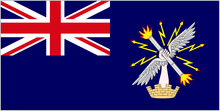 | Royal Engineers |
 | Royal Fleet Auxiliary Service |
| Royal Hospital School | |
 | Royal Maritime Auxiliary Service |
| Royal Ulster Constabulary | |
 | Scottish Office Agriculture and Fisheries Department |
 | Sea Cadet Corps |
| Submarine Mining Service | |
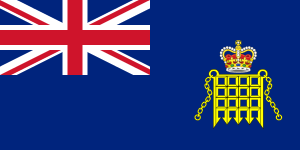 | UK Border Agency |
Yachting Blue Ensigns defaced by the badge of the club were recorded in the Navy List until 1985, and now they are administered by the Royal Yachting Association for the Ministry of Defence. Current defaced Blue Ensigns are:
| Aldeburgh Yacht Club | |
| Army Sailing Association | |
| Bar Yacht Club | |
| City Livery Yacht Club | |
| House of Lords Yacht Club | |
| Household Division Yacht Club | |
 | Little Ship Club |
| Medway Cruising Club | |
| Medway Yacht Club | |
| Old Worcesters Yacht Club | |
| Parkstone Yacht Club | |
 | Poole Yacht Club |
| Poole Harbour Yacht Club | |
 | Portsmouth Yacht Club |
| Royal Air Force Yacht Club | |
 | Royal Anglesey Yacht Club |
| Royal Armoured Corps Yacht Club | |
| Royal Artillery Yacht Club | |
| Royal Burnham Yacht Club | |
 | Royal Channel Islands Yacht Club |
| Royal Corinthian Yacht Club | |
 | Royal Cornwall Yacht Club |
| Royal Dee Yacht Club | |
 | Royal Forth Yacht Club |
 | Royal Harwich Yacht Club |
 | Royal Gibraltar Yacht Club |
| Royal London Yacht Club | |
| Royal Mersey Yacht Club | |
| Royal North of Ireland Yacht Club | |
| Royal Northumberland Yacht Club | |
| Royal Ocean Racing Club | |
| Royal Plymouth Corinthian Yacht Club | |
 | Royal Southampton Yacht Club |
 | Royal Torbay Yacht Club |
 | Royal Ulster Yacht Club |
| Royal Welsh Yacht Club | |
| Royal Yorkshire Yacht Club | |
| Severn Motor Yacht Club | |
 | Sussex Yacht Club |
| Thames Motor Yacht Club |
Flags of UK Overseas Territories using defaced blue ensigns
Current flags:
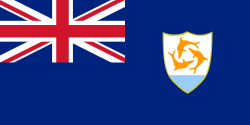 Flag of Anguilla
Flag of Anguilla Government Ensign of Bermuda (the flag commonly used on land is Bermuda's Red Ensign)
Government Ensign of Bermuda (the flag commonly used on land is Bermuda's Red Ensign)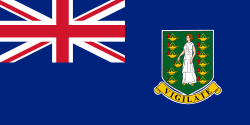 Flag of the British Virgin Islands
Flag of the British Virgin Islands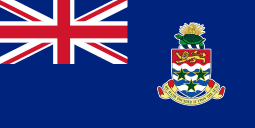 Flag of the Cayman Islands
Flag of the Cayman Islands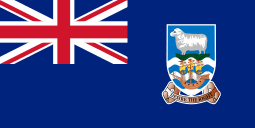 Flag of the Falkland Islands
Flag of the Falkland Islands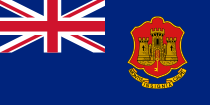 Government Ensign of Gibraltar (there is another flag, not based on an ensign, that is commonly used on land)
Government Ensign of Gibraltar (there is another flag, not based on an ensign, that is commonly used on land) Flag of Montserrat
Flag of Montserrat Flag of Pitcairn Islands
Flag of Pitcairn Islands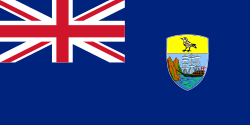 Flag of Saint Helena
Flag of Saint Helena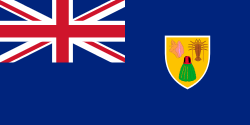 Flag of Turks and Caicos Islands
Flag of Turks and Caicos Islands
Former flags: The defaced blue ensign was formerly used as:
- The jack of the Royal Canadian Navy from its inception until the adoption of the Maple Leaf flag in 1965. (see Flags of the Royal Canadian Navy 1910–1965) The blue ensign was approved by the British Admiralty in 1868 for use by ships owned by the Canadian government.
-
.svg.png)
 Blue Ensign worn as a jack by the Royal Canadian Navy from 1921–1957 (with green maple leaves in the shield)
Blue Ensign worn as a jack by the Royal Canadian Navy from 1921–1957 (with green maple leaves in the shield) -
.svg.png)
 Blue Ensign worn as a jack by the Royal Canadian Navy from 1957–1965 (with red maple leaves in the shield)
Blue Ensign worn as a jack by the Royal Canadian Navy from 1957–1965 (with red maple leaves in the shield)
- The ensign (1879-1928) and the jack (1928-1947) of the Royal Indian Navy (HM Indian Marine: 1879-1892, Royal Indian Marine: 1892-1934, Royal Indian Navy: 1934-1950):
-

 Blue Ensign worn as an ensign (1879-1928) and a jack (1928-1947) of the Royal Indian Navy[1]
Blue Ensign worn as an ensign (1879-1928) and a jack (1928-1947) of the Royal Indian Navy[1]
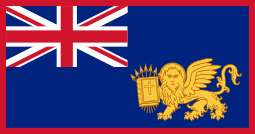 Flag of The United States of the Ionian Islands (a British amical protectorate, 1815–1864)
Flag of The United States of the Ionian Islands (a British amical protectorate, 1815–1864).svg.png) Flag of British Hong Kong (1870–1997) and the ensign of the Royal Hong Kong Police Force were based on the Blue Ensign.
Flag of British Hong Kong (1870–1997) and the ensign of the Royal Hong Kong Police Force were based on the Blue Ensign.
National flags based on the Blue Ensign
These include:
 Flag of Australia
Flag of Australia
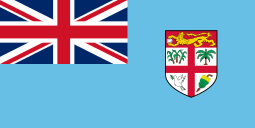 Flag of Fiji (light blue)
Flag of Fiji (light blue) Flag of New Zealand
Flag of New Zealand
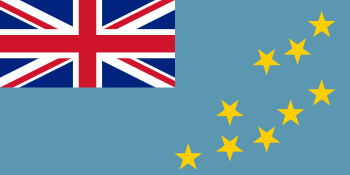 Flag of Tuvalu (light blue)
Flag of Tuvalu (light blue)
Other flags based on the Blue Ensign
See also
- British ensign
- Australian flag debate
- New Zealand flag debate
- Green Ensign
- Red Ensign
- White Ensign
- Ensign
References
- Notes
- ↑ An individual warrant is issued by the Secretary of State for Defence for each ship
- Footnotes
- ↑ Naval Staff Directorate. "Naval Flags and Ensigns" (PDF). p. 12. Retrieved 1 January 2013.
External links
| Wikimedia Commons has media related to Blue ensigns. |
- Blue Ensign page on the "Flags of the World" website
- UK, Naval, Government, Yacht clubs on flags.net